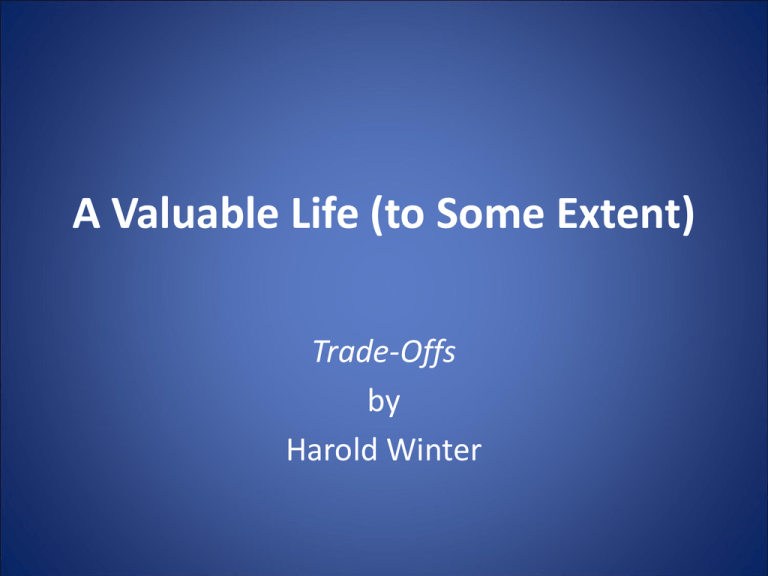A Valuable Life (to Some Extent)
advertisement

A Valuable Life (to Some Extent) Trade-Offs by Harold Winter Immoral and Repulsive? • Many are uncomfortable with the idea of equating a person's life with a finite dollar amount. • They often believe that a human life can only be infinitely valued. – To object is immoral and repulsive. 2 An Economist’s Response • An economist can convince an individual that she does not place an infinite value on her own life. • Why would she take even the slightest risk of losing her infinitely-valued life, especially just to attend a dinner party? – What some economists do explicitly, virtually every individual does implicitly—they place a finite value on human life. 3 Statistical Value of Life • Economists routinely use a statistical value of life estimate in policy analysis to measure trade-offs. – This is the value of life in a cost-benefit analysis sense—the dollar cost of improved safety must be compared to the dollar benefit of improved safety. • If the benefit is measured in lives saved, a dollar value of life is important to determine. 4 The Ford Pinto • The Ford Pinto case represents a tragic example of the application of value of life estimates in a cost-benefit framework. – On an Indiana highway in 1978, three girls between the ages of sixteen and eighteen were killed while driving a Ford Pinto. – Apparently, had Ford made an $11 modification in the design of the Pinto, the deaths of the girls may have been avoided. 5 6 Ford Pinto: Costs • Ford had undertaken a cost-benefit analysis. – Ford assigned a dollar value to the potential loss of human life in the event of just such an accident. • It was more cost effective for Ford to pay damages to the families of accident victims than it was to make the modification. • Cost: An $11 modification for the total number of Pintos on the road was approximately $138 million. 7 Benefits • Ford determined how many individuals would probably be killed or injured in a rear-end Pinto collision. – Using average liability amounts from wrongful death and injury litigation, they calculated their legal liability of not using the modification. – Using a liability amount of $200,000 for each person killed, and $67,000 for each person injured, they totaled their overall liability at approximately $50 million. 8 What was Ford Thinking? • Thousands of decisions must go into something as complicated as product design for an automobile. – Any single improvement in safety may cost just a few dollars, but if there are hundreds of potential safety modifications to consider, the improvements in safety may cost thousands of dollars. 9 Sound Business Decision? • Ford made a sound business decision for its shareholders. • Was it a sound business decision from society's perspective? – Proper cost-benefit analysis doesn't only require using a value of life estimate, it requires using the appropriate one. – But what is meant by appropriate? 10 How Valuable is a Life? • In a wrongful death case, part of the issue that must be determined by the judge or the jury is how to assign a damage award for the loss of life. – Damages based on contributions. • Benefits that would have been provided for the decedent's beneficiaries had there been no wrongful death. ($) – Damages based on loss to the estate. • Probable earnings of the decedent, less probable personal expenses, had there been no wrongful death.($) 11 A Social Perspective • From a social perspective, a value of life includes anything that can be considered valuable to the individual. – The goal of estimating the value of life, then, is to try to place a dollar value on both the pecuniary and nonpecuniary aspects of that value. 12 Social Value of Life • Individuals routinely take actions that suggest they are either willing to pay to avoid, or must be paid to incur, an increased risk of death. • Suppose you are trying to choose between two job offers. – Both jobs are completely identical to you except in two respects—one job has a slightly higher risk of death than the other job, and the wage rates may differ. 13 Example • The riskier job pays a wage premium relative to the less risky job. – It may be possible to identify the exact wage premium that makes you completely indifferent between the two jobs. – With that amount, and some idea of the difference in the risk factors of the two jobs, we can estimate a value of life. 14 Example (cont’d) • Suppose the riskier job has a one in ten thousand (1/10,000) higher death risk than the less risky job. • $500 minimum annual wage premium. • If 10,000 workers each giving an identical answer, we have a total of ($500X10,000), or $5 million. – In a statistical sense, then, we can say that one life is valued at $5 million. 15 Wage data • If a $500 annual wage premium is needed to compensate for a 1/10,000 risk premium, the statistical value of life estimate for an average worker is calculated to be $5 million. – The main advantage of using labor market data to estimate a statistical value of life is that we are using data based on observable market behavior. – There have been numerous empirical studies that have attempted to estimate a statistical value of life. 16 Statistical Value of Life • The range of estimates is generally between $3 million and $7 million. – This means that the typical wrongful death damage award is significantly below the statistical value of life estimate found in most empirical studies. 17 Back to the Ford Pinto • The problem with Ford's cost-benefit analysis was not that they were trading lives for dollars. – Ford correctly determined legal liability to be based on the $200,000 wrongful death damage estimate that the courts used. – If the social value of life estimate falls in the lower end of the $3 million to $7 million range, the dollar cost of not adding the safety modification in terms of life lost and injury would be close to $1 billion (not $50 million). – With the larger value of life estimate, the cost-benefit analysis shows that the safety modification would have been cost effective and should have been implemented. 18 Scarcity • If you accept the notion that there is a finite value of life for cost-benefit purposes, you necessarily accept the notion of trading lives for dollars. – This implies that there are some safety features that simply are not cost effective. • If too low a value is placed on the value of life, many safety features would be deemed not cost effective. • If too high a value is used, too many safety features would be considered cost effective. – But can you ever really have too many safety features? 19 Optimal Level of Safety • Every dollar of resources we spend somewhere is one dollar less we can spend elsewhere. • This is why it is important to carefully consider where the dollars are spent, even when considering saving lives. – A 1985 FAA regulation that implemented an aircraft cabin fire protection standard cost $100,000 per life saved. • In this case, pretty much any statistical value of life estimate you use would suggest that the regulation is extremely cost effective. 20 Safety (cont’d) • A 1978 OSHA regulation that implemented an arsenic occupational exposure limit cost $127 million per life saved. – Even if you use the very high end of the value of life estimates, this regulation does not appear to be justified. 21 Cotton Dust Standards • The Act directs the Secretary to issue the standard that "most adequately assures ... that no employee will suffer material impairment of health," limited only by the extent to which this is "capable of being done." In effect then... Congress itself defined the basic relationship between costs and benefits, by placing the "benefit" of worker health above all other considerations save those making attainment of the "benefit" unachievable. ... Thus, cost-benefit analysis by OSHA is not required by the statute because feasibility analysis is. • The implication of this ruling is that if a safety feature that reduces the risk of injury to a worker is technically feasible, the cost of that safety feature is not relevant in terms of policy implementation. 22 Implications • If you take this ruling literally, why not simply abolish the American cotton industry? – This is technically feasible, and it would reduce the risk of cotton dust-related illness to zero. – If you believe that abolishing a whole industry for the sake of worker safety is unwarranted, once again you accept the notion that there is a tradeoff between lives and dollars. • The manner in which you could resolve this trade-off, however, remains the interesting question. 23 Trade-Offs? • It is unlikely that OSHA completely ignores costs in determining occupational safety standards. – The most likely effect of the Supreme Court's ruling is that much more weight will be placed on the benefit of occupational safety features compared to the costs of such features. • This may account for why regulations that cost over $100 million per life saved are routinely proposed, and sometimes enacted. 24 Some Additional Thoughts • The Pinto case provides an excellent example of the difference between private costs and social costs. – Ford was concerned with the private cost of their decision not to include the additional safety feature, and this cost largely hinged on how the courts assessed the value of life. – But if the courts' assessment was well below the true social value of life, Ford's best private decision could diverge from the best social decision. 25 Social Policy • One role of social policy is to provide incentives for private parties to take into account the social costs they may impose on others. • Does the Pinto accident create a motivation for additional social control of automobile safety standards? – In this case, the answer may be yes. 26 Optimal Policy • The ultimate question that must be answered in designing social policy for health and safety issues is this: What is the optimal accident rate in any given risky situation? • The answer to this question must ultimately involve some form of cost-benefit analysis that trades lives for dollars, regardless of how much importance you place on the costs or benefits being considered. 27









